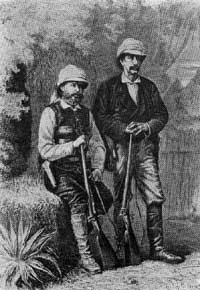Hermenegildo Capelo
Hermenegildo de Brito Capelo was born in Palmela, Portugal, a town about 25 km (16 mi) south of Lisbon.
In 1860, Capelo sailed to Angola, in southwest Africa, and served on board the D Estefânia as a member of the Portuguese Navy, which was commanded by Prince Luís, staying for three years at a naval station before returning to Lisbon in 1863.
Explorers of all European nations had launched themselves into rivalry for territorial gains, compelling Portugal to urgently review its own colonial position and the effectiveness of its presence in Africa.
Hermenegildo Capelo was chosen on May 11, 1877, to direct a scientific expedition into Central Africa alongside the marine official Roberto Ivens and Serpa Pinto.
Capelo and Ivens explored the region of Bié and up to the lands of Iaca, having delimited the course of the Luando, Kubango and the Tohicapa rivers.
Following a consolidation of gains in the region of the Bié Plateau and the Zambezi river and reaching the Victoria Falls, Hermenegildo Capelo and Roberto Ivens were stimulated and keen to embark upon a second, ambitious expedition.
As they continued their hydrographic studies and observations of river flow and drainage patterns, but also taking notes on the ethnographic and the linguistic characters of the people they encountered, they established a long-sought-after route via land between the coasts of Angola and Mozambique, exploring the vast regions of the interior located between these two territories.
Capelo and Ivens began this expedition on January 6, 1884, and returned to Lisbon on September 20, 1886, where they were triumphantly received by King Luís I of Portugal.
His vision and his eminent skills at organization and direction were of great service to Portugal, alongside Roberto Ivens, Andrade Corvo, Luciano Cordeiro, Pinheiro Chagas, António Enes and Oliveira Martins.
